Plains Indians
 From Nwe
From Nwe 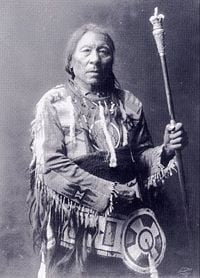
The Plains Indians are the Indigenous peoples who lived on the plains and rolling hills of the Great Plains of North America. They are often thought of as the archetypal American Indians, riding on horseback, hunting buffalo, wearing headdresses made with eagle feathers, and speaking in sign language. This is due at least in part to their lengthy and brave resistance to colonial demands, often violent resulting in suffering and death on both sides.
The nomadic lifestyle of these people, hunting the great buffalo herds without restriction, was incompatible with the lifestyle of the European settlers. Even religious efforts such as the Ghost Dance movement, failed to bring about harmony and even, as in the Wounded Knee massacre, led to greater bloodshed. In the end, both the buffalo (more correctly bison) and the Plains lifestyle reached a level close to extinction, with those that survived resigned to life on the reservation. Today, however, some remain and some form of revival is possible. The bison are no longer in danger of extinction and are found on private ranches, public parks including Yellowstone National Park, and wildlife preserves where they roam the tallgrass prairies again, albeit in smaller numbers and over a much smaller area. The Plains lifestyle may never return to its former glory. However, their great chiefs and their struggles, both the heroic and the simply violent, have been documented and have continued to provide material for entertainment as well as education.
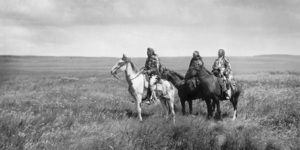
Languages
Consisting of a large number of different tribes, the Plains Indians spoke a variety of languages. These include languages from the Algonquian, Siouan, Caddoan, Ute-Aztecan, Athabaskan, and Kiowa-Tanoan languages. Thus, for example, the Sioux, Crow, Omaha, Osage, Ponca, and Kansa spoke variations of the Siouan language while the Arapaho, Blackfoot, and Cheyenne spoke Algonquian languages.
Plains Indian Sign Language (PISL) is a sign language formerly used as an auxiliary interlanguage among these Plains Indians tribes whose spoken languages were so different. As nomadic peoples they encountered other tribes speaking other languages and the sign language developed to permit communication among them. Involving the use of hand and finger positions to represent ideas, PISL consists of symbolic representations that were understood by the majority of the tribes in the Plains. It has been suggested that this silent form of communication was of particular importance in their hunting culture, as it permitted communication without disturbing their prey. Given that their targets were buffalo living in huge herds that traveled great distances, many hunters were needed and they had to travel far to find them. Thus, the more universal sign language supported cooperation among different tribes without requiring a common spoken language (U.S. Department of the Interior 2003).
In 1885, it was estimated that there were over 110,000 “sign-talking Indians,” including Blackfoot, Cheyenne, Sioux, and Arapaho. By the 1960s, there remained a “very small percentage of this number” (Tomkins 1969). There are few PISL signers alive today.
History

Plains Indians are so called because they roamed across the Great Plains of North America. This region extends from the Mississippi River in the east to the Rocky Mountains in the west, and from present-day Canadian provinces of Manitoba, Saskatchewan, and Alberta in the north to central Texas in the south. The area is primarily treeless grassland. In the wetter parts, in the Mississippi valley, there are tall grasses and this region is also known as the prairies.
The Plains Indians can be divided into two broad classifications, which overlap to some degree. The first group were fully nomadic, following the vast herds of bison, although some tribes occasionally engaged in agriculture—primarily growing tobacco and corn. The Blackfoot, Arapaho, Assiniboine, Cheyenne, Comanche, Crow, Gros Ventre, Kiowa, Lakota, Lipan, Plains Apache (or Kiowa Apache), Plains Cree, Sarsi, Sioux, Shoshone, and Tonkawa belong in this nomadic group.
The second group of Plains Indians (sometimes referred to as Prairie Indians as they inhabited the Prairies) were semi-sedentary tribes who, in addition to hunting bison, lived in villages and raised crops. These included the Arikara, Hidatsa, Iowa, Kaw (or Kansa), Mandan, Omaha, Osage, Otoe, Pawnee, Ponca, and Wichita.
Bison was essential to the survival of all the Plains Indians. It is estimated that there were about 30 million bison in North America in the 1500s. The National Bison Association lists over 150 traditional Native American uses for bison products, besides food (NBA 2006).
After European contact
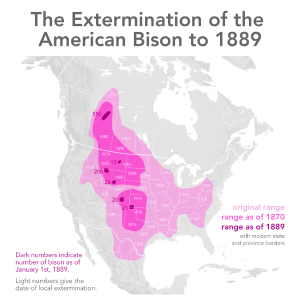
As Americans of European descent moved into Native American lands, the bison were significantly reduced through overhunting. Some of the reasons for this were to free land for agriculture and cattle ranching, to sell the hides of the bison, to deprive hostile tribes of their main food supply, and for what was considered sport. The worst of the killing took place in the 1870s and the early 1880s. By 1890, there were fewer than 1000 bison in North America (Nowak 1983). Zoologist William Temple Hornaday described what happened:
With the building of three lines of railway through the most populous buffalo country there came a demand for robes and hides … and then followed a wild rush of hunters … eager to destroy as many head as possible in the shortest time. … For those greedy ones, the chase on horseback was too slow and too unfruitful. That was a retail method of killing, whereas they wanted to kill by wholesale (Hornaday 1889).

There were government initiatives at the federal and local level to starve the population of the Plains Indians by killing off their main food source, the bison. The Government promoted bison hunting for various reasons: to allow ranchers to range their cattle without competition from other bovines and to weaken the Indian population and pressure them to remain on reservations (Moulton and Sanderson 1998). The herds formed the basis of the economies of local Plains tribes of Native Americans for whom the bison were a primary food source. Without bison, the Native Americans would be forced to leave or starve.
The railroad industry also wanted bison herds culled or eliminated. Herds of bison on tracks could damage locomotives when the trains failed to stop in time. Herds often took shelter in the artificial cuts formed by the grade of the track winding though hills and mountains in harsh winter conditions. As a result, bison herds could delay a train for days.
As the great herds began to wane, proposals to protect the bison were discussed. But these were discouraged since it was recognized that the Plains Indians, often at war with the United States, depended on bison for their way of life. By 1884, the American bison was close to extinction. Facing starvation, most tribes accepted confinement in reservations; and the traditional Plains Indians way of life was essentially over.
Indian wars
European expansion into the plains and mountains by miners, ranchers, and settlers led to increasing conflicts with the Plains Indians. Many tribes fought the whites at one time or another, but the Sioux provided significant opposition to encroachment on tribal lands. Led by resolute, militant leaders, such as Red Cloud and Crazy Horse, the Sioux were skilled at high-speed mounted warfare, having learned to ride horses in order to hunt bison.

Conflict with the Plains Indians continued through the Civil War. The Dakota War of 1862 was the first major armed engagement between the U.S. and the Sioux. After six weeks of fighting in Minnesota led by Chief Taoyateduta (Little Crow), over 300 Sioux were convicted of murder and rape by U.S. military tribunals and sentenced to death. Most of the death sentences were commuted, but on December 26, 1862, in Mankato, Minnesota, 38 Dakota Sioux men were hanged in what is still today the largest mass execution in U.S. history (Carley 1961).
In 1864, one of the more infamous Indian War battles took place, the Sand Creek Massacre in southeast Colorado. The Indians at Sand Creek had been assured by the U.S. Government that they would be safe in the territory they were occupying, but anti-Indian sentiments by white settlers were running high. A locally raised militia attacked the village of Cheyenne and Arapaho, killing and mutilating an estimated 150 men, women, and children.
In 1875, the last serious Sioux war erupted, when the Dakota gold rush penetrated the Black Hills. In 1876, after several indecisive encounters, General George Custer found the main encampment of the Lakota and their allies at the Battle of Little Big Horn. Custer and his men — who were separated from their main body of troops—were killed by the far more numerous Indians who had the tactical advantage. They were led in the field by Crazy Horse and inspired by Sitting Bull's earlier vision of victory.
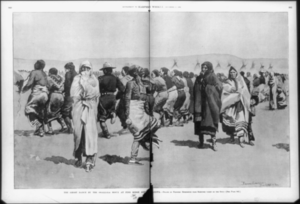
The Ghost Dance, originally a peaceful spiritual movement, played a significant role in instigating the Wounded Knee massacre in 1890, which resulted in the deaths of at least 153 Lakota Sioux (Utley 2004). While most followers of the Ghost Dance understood Wovoka’s role as being that of a teacher of pacifism and peace, others did not. An alternate interpretation of the Ghost Dance tradition is seen in the so-called Ghost Shirts, which were special garments rumored to repel bullets through spiritual power. Chief Kicking Bear brought this concept to his own people, the Lakota Sioux, in 1890 (Kehoe 2006).
Performances of the Ghost Dance ritual frightened the supervising agents of the Bureau of Indian Affairs (BIA), who had been given the responsibility of supplementing the Sioux with food and hiring white farmers as teachers as they adjusted to reservation life. Kicking Bear was forced to leave Standing Rock, but when the dances continued unabated, Agent McLaughlin asked for more troops, claiming that Hunkpapa spiritual leader Sitting Bull was the real leader of the movement. Thousands of additional U.S. Army troops were deployed to the reservation. In December, Sitting Bull was arrested on the reservation for failing to stop his people from practicing the Ghost Dance (Kehoe 2006). During the incident, a Sioux witnessing the arrest fired at one of the soldiers prompting an immediate retaliation; this conflict resulted in deaths on both sides, including the loss of Sitting Bull himself.
Big Foot, a Miniconjou leader on the U.S. Army’s list of trouble-making Indians, was stopped while en route to convene with the remaining Sioux chiefs. U.S. Army officers forced him and his people to relocate to a small camp close to the Pine Ridge Agency so that the soldiers could more closely watch the old chief. That evening, the small band of Sioux erected their tipis on the banks of Wounded Knee Creek. The following day, during an attempt by the officers to collect any remaining weapons from the band, a deaf Sioux warrior refused to relinquish his arms. A struggle followed in which a rifle was discharged and the U.S. forces opened fire; the Sioux responded by taking up previously confiscated weapons. When the fighting was over, 25 U.S. soldiers lay dead, many killed by friendly fire, amongst the 153 dead Sioux, most of whom were women and children (Kehoe 2006). This ended the Indian Wars. The spirit of the Sioux was crushed, the Ghost Dancers soon stopped dancing, and the U. S. Census Bureau announced that there was no longer a frontier on the maps—the Great Plains (apart from a few scattered reservations) now belonged to the United States (Waldman 2006).
Culture
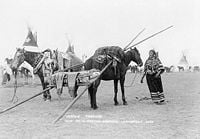
The nomadic Plains Indian tribes survived on hunting, and bison was their main food source. American buffalo, or simply buffalo, is the commonly used (but inaccurate) name for the American Bison, and this group are sometimes referred to as part of the "Buffalo Culture." Bison were the chief source for items which Indians made from their flesh, hide and bones, such as food, cups, decorations, crafting tools, knives, and clothing. Not a single part of the animal was thrown away.
The tribes kept moving following the bison on their seasonal and grazing migrations. Prior to the introduction of horses, they used dogs to pull their belongings loaded on simple V-shaped sleds, known as "travois." Native horses had died out in prehistoric times, and so the introduction of horses by the Spanish made a significant change in their lifestyle. When escaped Spanish horses were obtained, the Plains tribes rapidly integrated them into their daily lives, wealth, and hunting techniques. They fully adopted a horse culture in the eighteenth century (Waldman 2006).
Hunting
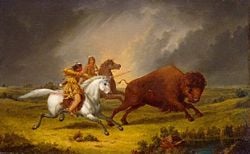
Although the Plains Indians hunted other animals, such as elk or antelope, bison was their primary game food source. Before horses were introduced, hunting was a more complicated process. They would surround the bison, and then try to herd them off cliffs or into places where they could be more easily killed. The tribesmen might build a corral and herd the buffalo into it to confine them in a space where they could be killed.
Prior to their adoption of guns, the Plains Indians hunted with spears, bows and arrows, and various forms of clubs. When horses, brought by the Spanish to America, escaped and started breeding in the wild, the Indians quickly learned how to capture and train them. Their ability to ride horses made hunting (and warfare) much easier. With horses, they had the means and speed to stampede or overtake the bison. They continued to use bows and arrows after the introduction of firearms, because guns took too long to reload and were too heavy. Later, the adopted the lighter and more accurate rifles for hunting and warfare. In the summer, many tribes gathered for hunting in one place. The main hunting seasons were fall, summer, and spring. In winter harsh snow and mighty blizzards made it almost impossible to kill the bison.
Housing
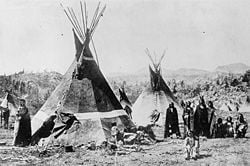
The tipi, a conical tent originally made of animal skins or birch bark, was the traditional home of the Plains Indians. It was durable, provided warmth and comfort in winter, was dry during heavy rains, and was cool in the heat of summer.
Tipis consist of four elements: a set of poles, a hide cover, a lining, and a door. Ropes and pegs are used to bind the poles, close the cover, attach the lining and door, and anchor the resulting structure to the ground. Tipis are distinguished by opening at the top and the smoke flaps, which allow the dweller to cook and heat themselves with an open fire while allowing a source of fresh air, and the lining that is primarily used in the winter, providing insulation. Tipis are designed to be easily set up to allow camps to be moved to follow game migrations, especially the bison. The long poles could be used to construct a dog- or later horse-pulled travois. They could be disassembled and packed away quickly when a tribe decided to move, and could be reconstructed quickly when the tribe settled in a new area. Such portability was important to those Plains Indians who had a nomadic lifestyle.
Some tipis were painted in accordance with traditional tribal designs and often featured geometric portrayals of celestial bodies and animal designs, or depicted personal experiences, such as war or hunting. In the case of a dream or vision quest, “ceremonies and prayers were first offered, and then the dreamer recounted his dream to the priests and wise men of the community…. Those known to be skilled painters were consulted, and the new design was made to fit anonymously within the traditional framework of [the tribe’s] painted tipis” (Goble 2007). While most tepees were not painted, many were decorated with pendants and colored medallions. Traditionally these were embroidered with dyed porcupine quills. Bison horns and tails, tufts of buffalo and horse hair, bear claws, and buckskin fringe were also used to decorate tipi covers.
In addition to the tipis, earth lodges were also used as housing by the semi-sedentary tribes, most specifically the Mandan, Hidatsa, and Arikara. Most earth lodges are circular in construction with a dome-like roof, often with a central or slightly offset smoke hole at the apex of the dome. They were significantly larger than tipis, and often housed three-generation families.
Earth lodges were typically constructed using a wattle and daub technique with a particularly thick coating of earth. During construction, an area of land was first dug a few feet beneath the surface, allowing the entire building to have a floor somewhat beneath the surrounding ground level. Posts were set into holes in the ground around the edges of the earth lodge, and their tops met in or near the middle. After a strong layer of sticks or reeds was wrapped through and over the radiating roof timbers, a layer of thatch was often applied as part of the roof, although the structure was then entirely covered in earth. This earth layer provides insulation against extreme temperatures, as does the partially subterranean foundation.
Counting coup
Plains Indian warriors won prestige, known as "counting coup," by acts of bravery in the face of the enemy. Any blow struck against the enemy counted as a coup, but the most prestigious acts included touching an enemy warrior, with the hand or with a "coup stick," and then escaping unharmed. Counting coup could also involve stealing from the enemy. Risk of injury or death was required to count coup.
Coups were recorded by notches in the coup stick, or by feathers in the headdress of a warrior who was rewarded with them for an act of bravery.
The term is of French origin from the word coup which means a hit, a blow or a strike. The expression can be seen as referring to "counting strikes."
Headdress
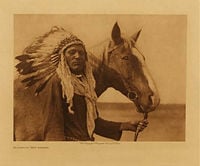
Feathered war bonnets (or headdresses) were a military decoration developed by the Plains Indians. A chief's war bonnet was comprised of feathers received for good deeds to his community and worn in high honor. Each feather would represent a good deed. The eagle was considered the greatest and most powerful of all birds and thus, the finest bonnets were made out of its feathers.
The bonnet was only worn on special occasions and was highly symbolic. Its beauty was of secondary importance; the bonnet's real value was in its power to protect the wearer.
The bonnet had to be earned through brave deeds in battle because the feathers signified the deeds themselves. Some warriors might obtain only two or three honor feathers in their whole lifetime, so difficult were they to earn. A high honor, for example, was received by the warrior who was the first to touch an enemy fallen in battle, for this meant the warrior was at the very front of fighting. Feathers were notched and decorated to designate an event and told individual stories such as killing, scalping, capturing an enemy's weapon and shield, and whether the deed had been done on horseback or foot.
After about ten honors had been won, the warrior went out to secure the eagle feathers with which to make his bonnet. In some tribes these had to be purchased from an individual given special permission to hunt the bird. Others permitted a warrior to hunt his own eagles. This was a dangerous and time-consuming mission as it involved leaving the tribe and traveling to the high country where the bird could be found. When the destination had been reached, ceremonies were conducted to appeal to the spirits of the birds to be killed.
Art
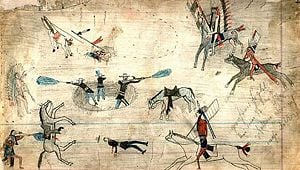
Plains Indians used traditional pictographs to keep historical records and serve as mnemonic reminders for storytelling. A traditional male art form, warriors drew pictographic representations of heroic deeds and sacred visions rocks and animal skins, which served to designate their positions in the tribe. This traditional form required an economy of means in drawing, such that delicate "stick figures" with limited detail are found in the earliest works. The influence of European artistic style as well as photography influenced later works resulting in finely elaborated lines, patterns, and landscapes (Berlo 1997).
In captivity following the Indian Wars, a number of Plains Indians, particularly the Lakota, Cheyenne, Arapaho, and Kiowa, were able to use the lined pages of the white man's record keeping books (ledgers) for their artworks, resulting in "ledger art." At Fort Marion, St. Augustine, Florida Captain Richard Henry Pratt initiated an educational experiment as an alternative to standard imprisonment, culminating in his founding of the Carlisle Indian School in 1879. The Plains Indian leaders followed Pratt's rules and met his educational demands even as they remained true to their own identities, practicing traditional dances and ceremonies (Lookingbill 2006). In addition to regular studies Pratt encouraged them to pursue their native arts and to sell the products, keeping the profits for themselves. These artworks became an important source of chronicling the traditional ways, and resisting acculturation. Their drawings "speak on many levels about native history, oppression, resistance, autonomy, and the powerful human urge to draw" (Berlo 1997).
Religion
The Plains Indians followed no single religion. Animist beliefs were an important part of a their life, as they believed that all things possessed spirits. Their worship was centered on one main god, in the Sioux language Wakan Tanka (the Great Spirit). The Great Spirit had power over everything that had ever existed. Earth was also important, as she was the mother of all spirits.
There were also people that were wakan, or blessed, also called shaman. To become wakan, your prayers must be answered by the Great Spirit, or you must see a sign from him. Shamans were thought to possess great power. One of their jobs was to heal people, which is why they are also sometimes called "medicine men." The shamans were considered so important that they were the ones who decided when the time was right to hunt.
Sacred objects
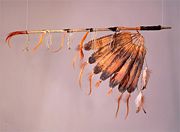
Plains Indians believed that some objects possessed spiritual or talismanic power. One such item was the medicine bundle, which was a sack carrying items believed by the owner to be important. Items in the sack might include rocks, feathers, and more. Another object of great spiritual power was the shield. The shield was the most prized possession of any warrior, and he decorated it with many paintings and feathers. The spirits of animals drawn on the shield were thought to protect the owner.
A peace pipe, also called a "calumet" or "medicine pipe," was used by many Plains Indians tribes as a ceremonial smoking pipe, traditionally as a token of peace. A common material for calumet pipe bowls is red pipestone or catlinite, a fine-grained easily-worked stone of a rich red color of the Coteau des Prairies, west of the Big Stone Lake in South Dakota. The quarries were formerly neutral ground among warring tribes; many sacred traditions are associated with the locality. A type of herbal tobacco or mixture of herbs was usually reserved for special smoking occasions, with each region's people using the plants that were locally considered to have special qualities or a culturally accepted basis for ceremonial use.
Vision quest
Plains Indians sought spiritual help in many aspects of their life; usually by means of a vision quest. This involved going to a lonely spot where the individual would fast and ask for aid. If successful, a spirit-being would appear in a dream or supernatural vision and give instructions that would lead to success in the individual's endeavor.
Commonly both men and women participated in vision quests; children would undertake their first vision quest at an age as young as six or seven years although the age of the first quest varied from tribe to tribe. In some tribes the first vision quest was a rite of passage, marking an individual's transition from childhood to adulthood. In some tribes only males participated in vision quests; menarche (the onset of menstruation) marking the transition to adulthood for females.
Sun Dance
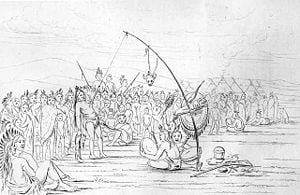
The Sun Dance is a ceremony practiced by a number of Native Americans, and was one of the most important rituals practiced by Plains Indians. Each tribe has its own distinct rituals and methods of performing the dance, but many of the ceremonies have features in common, including dancing, singing, praying, drumming, the experience of visions, fasting, and in some cases piercing of the chest or back. Most notable for early Western observers was the piercing many young men endure as part of the ritual. Frederick Schwatka wrote about a Sioux Sun Dance he witnessed in the late 1800s:
Each one of the young men presented himself to a medicine-man, who took between his thumb and forefinger a fold of the loose skin of the breast—and then ran a very narrow-bladed or sharp knife through the skin—a stronger skewer of bone, about the size of a carpenter's pencil was inserted. This was tied to a long skin rope fastened, at its other extremity, to the top of the sun-pole in the center of the arena. The whole object of the devotee is to break loose from these fetters. To liberate himself he must tear the skewers through the skin, a horrible task that even with the most resolute may require many hours of torture (Schwatka 1889).
In fact, the object of being pierced is to sacrifice one's self to the Great Spirit, and to pray while connected to the Tree of Life, a direct connection to the Great Spirit. Breaking from the piercing is done in one moment, as the man runs backwards from the tree at a time specified by the leader of the dance. A common explanation, in context with the intent of the dancer, is that a flesh offering, or piercing, is given as part of prayer and offering for the improvement of one's family and community.
Ghost Dance
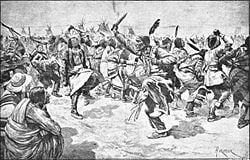
The Ghost Dance was a religious movement incorporated into numerous Native American belief systems. At the core of the movement was the prophet of peace Jack Wilson, known as Wovoka among the Paiute, who prophesied a peaceful end to white American expansion while preaching messages of clean living, an honest life, and cross-cultural cooperation. The traditional ritual used in the Ghost Dance, the circle dance, had been used by many Native Americans since prehistoric times, but was first performed in accordance with Jack Wilson's teachings among the Nevada Paiute in 1889.
As the Ghost Dance spread from its original source, Native American tribes synthesized selective aspects of the ritual with their own beliefs, often creating change in both the society that integrated it and the ritual itself. The Sioux variation on the Ghost Dance tended towards millenarianism, an innovation which distinguished the Sioux interpretation from Jack Wilson's original teachings.
Contemporary Life
While the Plains Indian culture of hunting bison and roaming freely across the Great Plains is no more, many tribes of this group have found other ways to live. Limited to their reservations, they turned to agriculture, artworks, casinos, and other forms of support. While some aspects of their culture have been retained, and members of the different tribes often gather at pow-wows to celebrate their heritage, tribes have also diversified depending upon their circumstances. Many have attained federal recognition, or First Nation status in Canada, and some have fought long battles to regain the rights to their traditional homelands. For example, the Northern Cheyenne earned their right to remain in the north near the Black Hills and have a bison herd, for which they are preparing to expand the grazing land to increase and improve the genetic quality which has deteriorated through in-breeding. In this and many other ways, the different tribes of the Plains Indians culture work to retain the resources of the past as well as contribute to the world of the future.
References
ISBN links support NWE through referral fees
- Associated Press. 2008. Bison roundup shows species' prairie recovery, Associated Press, November 28, 2008. Retrieved November 29, 2008.
- Berlo, Janet Catherine. 1996. Plains Indian Drawings 1865-1935. Harry N. Abrams. ISBN 978-0810937420.
- Berlo, Janet Catherine. 1997. Plains Indian Drawings. Tribal Arts. Retrieved October 28, 2008.
- Brown, Dee. [1970] 2007. Bury My Heart at Wounded Knee: An Indian History of the American West. Holt ISBN 978-0805086843.
- Carley, Kenneth. 1961. The Sioux Uprising of 1862. St. Paul, MN: Minnesota Historical Society.
- Carlson, Paul H. 1998. The Plains Indians. College Station, TX: Texas A&M University Press. ISBN 0890968284.
- Du Bois, Cora. [1939] 2007. The 1870 Ghost Dance. Lincoln, NE: University of Nebraska Press. ISBN 978-0803266629
- Goble, Paul. 2007. Tepee: Home of the Nomadic Buffalo Hunters. World Wisdom Books. ISBN 193331639X.
- Kehoe, Alice Beck. 2006. The Ghost Dance: Ethnohistory and Revitalization. Waveland Press. ISBN 978-1577664536.
- Lookingbill, Brad D. 2006. War Dance at Fort Marion: Plains Indian War Prisoners. Norman, OK: University of Oklahoma Press. ISBN 978-0806137391.
- Moulton, Michael, and James Sanderson. 1998. Wildlife Issues in a Changing World. Boca Raton, FL: CRC Press. ISBN 1566703514.
- NBA. 2008. Byproducts: Nature's Bountiful Commissary for the Plains Indians. National Bison Association website. Retrieved November 5, 2008.
- Nowak, Ronald M. 1999. Walker's Mammals of the World. Baltimore, MD: Johns Hopkins University Press. ISBN 0801857899.
- Osterreich, Shelley Anne. 1991. The American Indian Ghost Dance, 1870 and 1890. New York, NY: Greenwood Press. ISBN 031327469X.
- Stannard, David E. 1993. American Holocaust: The Conquest of the New World. Oxford University Press. ISBN 0195085574.
- Taylor, Colin E. 1994. The Plains Indians: A Cultural and Historical View of the North American Plains Tribes of the Pre-Reservation Period. New York, NY: Crescent Books. ISBN 0517142503.
- Thornaday, William Temple. [1889] 2008. The Extermination of the American Bison. Dodo Press. ISBN 978-1406568530.
- Tomkins, William. [1931] 1969. Indian Sign Language. New York, NY: Dover Publications 1969. ISBN 048622029X.
- Schwatka, Frederick. [1889] 1994. The Sun-Dance of the Sioux. Century Magazine 39: 753-759. Retrieved November 5, 2008.
- U.S. Department of the Interior. 2003. Plains Indian Sign Language: A Memorial to the Conference September 4-6, 1940, Browning, Montana. Indian Arts and Crafts Board. Retrieved November 5, 2008.
- Utley, Robert M. 2004. The Last Days of the Sioux Nation. New Haven, CT: Yale University Press. ISBN 0300103166
- Waldman, Carl. 2006. Encyclopedia of Native American Tribes. New York, NY: Checkmark Books. ISBN 978-0816062744.
External links
All links retrieved November 24, 2022.
- The Plains Indian Museum
- Plains Indian Ledger Art
|
||||||||
Credits
New World Encyclopedia writers and editors rewrote and completed the Wikipedia article in accordance with New World Encyclopedia standards. This article abides by terms of the Creative Commons CC-by-sa 3.0 License (CC-by-sa), which may be used and disseminated with proper attribution. Credit is due under the terms of this license that can reference both the New World Encyclopedia contributors and the selfless volunteer contributors of the Wikimedia Foundation. To cite this article click here for a list of acceptable citing formats.The history of earlier contributions by wikipedians is accessible to researchers here:
- Plains_Indians history
- Sun_Dance history
- Ghost_Dance history
- Plains_Indian_Sign_Language history
- Counting_coup history
- War_bonnet history
The history of this article since it was imported to New World Encyclopedia:
- History of "Plains Indians"
Note: Some restrictions may apply to use of individual images which are separately licensed.
↧ Download as ZWI file | Last modified: 02/04/2023 03:08:08 | 93 views
☰ Source: https://www.newworldencyclopedia.org/entry/Plains_Indians | License: CC BY-SA 3.0
 ZWI signed:
ZWI signed: KSF
KSF